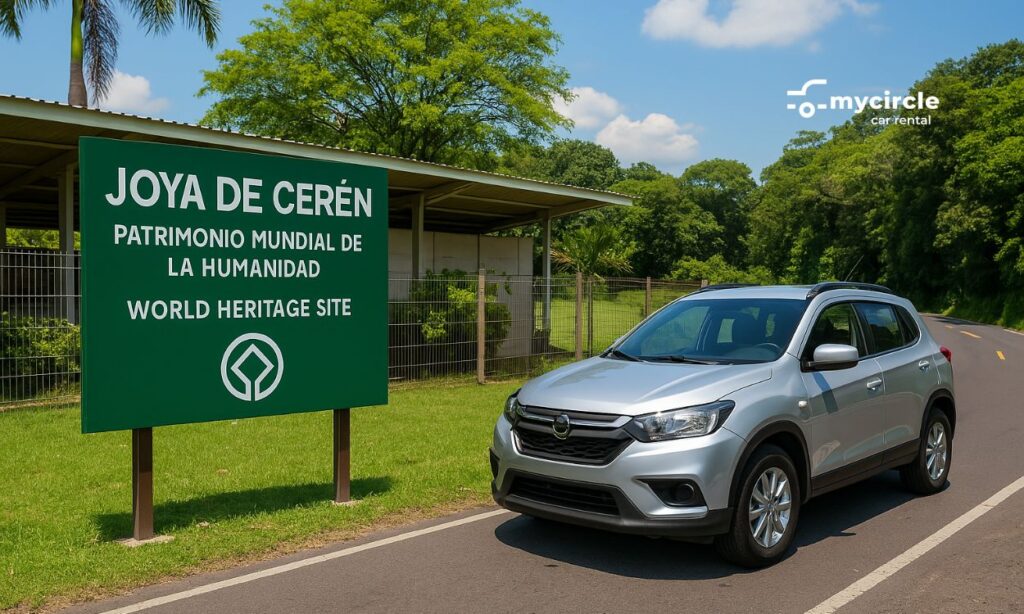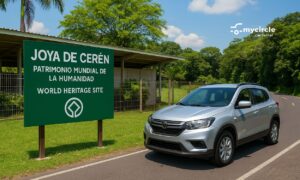If you’re looking for a unique archaeological site in El Salvador that combines history, culture, and easy access, you’re probably wondering how to visit Joya de Cerén by car: history, hours, and nearby places to explore. This UNESCO World Heritage Site is often called the “Pompeii of the Americas” due to its exceptional level of preservation after being buried by a volcanic eruption over 1,400 years ago.
In this guide, you’ll learn how to get there, what to see, opening hours, entrance fees, and other places to visit nearby. We also share practical tips to help you organize your trip.
What is Joya de Cerén and why visit?
Joya de Cerén is an ancient pre-Hispanic Mayan farming village preserved under volcanic ash following the eruption of the Loma Caldera volcano in the 7th century. Unlike ceremonial sites, here you can discover how ordinary people lived—through their homes, kitchens, crops, and daily tools.
It’s one of the few places in Latin America offering an authentic glimpse into pre-Columbian indigenous life. Visiting is an enriching experience for tourists, students, and researchers alike.
Want to add this destination to your cultural itinerary? Find curated routes and recommended experiences at My Circle SV, where you can plan your trip with local insight.
How to get to Joya de Cerén by car from San Salvador
Recommended route:
- Depart San Salvador via the Pan-American Highway (CA-1) heading west.
- Take the road toward Santa Ana.
- Before reaching San Juan Opico, follow the clearly marked signs to the archaeological site.
The total drive is about 35 km and takes 40 to 50 minutes, depending on traffic.
Road conditions:
- Good condition.
- Well signposted.
- Waze or Google Maps work perfectly.
Hours, entrance fees, and available services
- Opening hours: Tuesday to Sunday, 9:00 a.m. to 4:00 p.m.
- Closed on Mondays.
- Admission: $3 for locals, $5 for foreigners.
- Free entry for Salvadoran students with valid ID.
- Available services: Parking, restrooms, rest areas, and local guides.
We recommend hiring a site guide to fully understand the history and significance of each structure.
What to see at Joya de Cerén
- Adobe homes: Fully preserved with visible wall and structural details.
- Kitchens and domestic areas: Featuring original utensils.
- Temazcal (steam bath): One of the oldest in Mesoamerica.
- Farming plots and storage: Evidence of an economy based on maize, beans, and cassava.
- Interpretation center: Informative panels, models, and a brief exhibit.
Tips for visiting Joya de Cerén by car
- Arrive early to avoid the midday heat.
- Bring water and a hat: There’s shade, but it can get hot.
- Wear comfortable shoes for walking on dirt paths.
- No food allowed inside: There are designated eating areas outside.
- Follow signs and guidelines to help preserve the site.
What else to explore near Joya de Cerén
One of the great advantages of this site is its proximity to other attractions, making it easy to plan a full day trip.
1. San Andrés Archaeological Site
Just 5 minutes away by car. Features ceremonial Mayan structures, plazas, and a small museum.
2. El Boquerón National Park
Located on the San Salvador volcano, about 45 minutes from Joya de Cerén. Ideal for panoramic views and short hikes.
3. Lake Coatepeque
One of the country’s most beautiful lakes, about an hour away by car. Great for lunch, swimming, or relaxing after a cultural day.
4. Ruta de las Flores (Nahuizalco and Juayúa)
If you have more time, continue your trip along this route known for its culture, food, and cool climate.
Want to combine several destinations with strategic stops? Browse suggested itineraries on My Circle SV, where you can personalize your journey.
Where to eat near Joya de Cerén
- Restaurante El Mirador de Opico: Just minutes from the site, serving traditional Salvadoran food.
- Cafés in Santa Tecla: If returning through the city, there are modern, cozy options.
- Local eateries in San Juan Opico: Affordable with homemade meals.
Recommended accommodations if staying in the area
- Hotel Santa Elena (Santa Tecla): Ideal if you want to stay nearby without heading back to the city.
- Hostels near Coatepeque: Perfect if you plan to visit the lake the next day.
- Hotels in San Salvador: For more comfort and proximity to other points of interest.
Find vetted and traveler-reviewed stays on My Circle SV, with filters for price, distance, and travel style.
Best time to visit Joya de Cerén
You can visit year-round, but the dry season (November to April) is ideal for walking and enjoying clear views of the site. In the rainy season (May to October), the landscape is greener but the ground may be damp.
Is Joya de Cerén safe to visit?
Yes. The site is very safe and has on-site security. Being close to the city and other tourist zones, it’s frequently visited by both locals and foreigners. We recommend:
- Not leaving valuables in plain sight inside your car.
- Respecting official hours.
- Using authorized parking.
Visiting Joya de Cerén by car is an excellent option for travelers interested in learning about El Salvador’s pre-Columbian past comfortably and at their own pace. Whether part of a broader archaeological route or a standalone visit, this site offers a unique cultural experience.To better plan your route, receive personalized tips, and combine your visit with other attractions, head to My Circle SVand design the perfect getaway with trustworthy local support.


